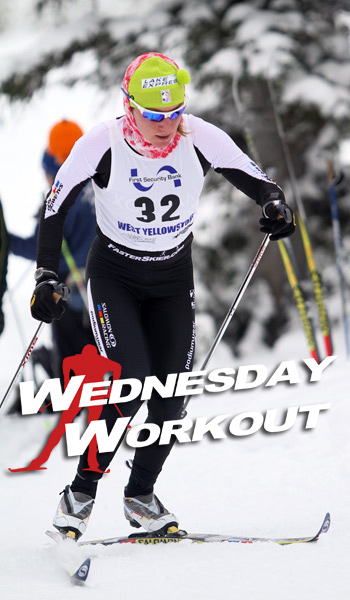
Remember the Pro Workout? As you may or may not have already figured out, the Wednesday Workout is our weekly reincarnation. This week, we bring back a Pro Workout of the past, which features advice from Caitlin Gregg of Team Madshus/Gregg, formerly Caitlin Compton of Central Cross Country (CXC), from December 2010. See the original here.
***
[Circa December 2010, by Topher Sabot] In the past, our “Pro Workout” series has featured a single training session from an elite North American skier, but this week CXC’s Caitlin Compton gives us a slightly different take.
Instead of detailing a favorite workout, Compton addresses an oft-ignored aspect of race preparation – the ability to respond to challenging and unexpected circumstances.
Over the past several years, major North American events have been disrupted by everything from volcanic eruptions to frigid temperatures to low snow.
This is all part of being an outdoor endurance athlete, Compton explains, but how you respond can have a major impact on your success.
“You need to have the ability to be flexible and to understand that there are some things you can’t control,” Compton says. “But there are tons of options. The beauty of cross-country skiing is that we do lots of cross-training in the offseason.”
This variety means that skiers can easily turn to alternative training methods when plans need to be changed.
Compton keeps her body in running form with regular jogs throughout the ski season, meaning she can easily throw in a significant foot session – even intervals – without experiencing any soreness.
And while training indoors is often a last resort for skiers, a local gym can be a perfect fallback plan if weather forces you off the trails.
“There is always a chance that conditions may be less than ideal for a huge event,” says Compton, noting that many athletes expect that the biggest races will automatically have perfect skiing – something that rarely comes to pass, be it U.S. nationals or the Olympics.
So an athlete’s response to less than ideal circumstances throughout the year can be an important part of her preparation.
“A good way to approach an alternate workout is to think, ‘if this comes up again, I will be ready,’” explains Compton.
“The approach is the most important,” she continues. “The goal is to not let it affect you and mentally stay positive, and look at it as an opportunity to practice and have fun overcoming the adversity.”
She also points out that workouts within two weeks of a competition will not have a significant impact on fitness, so you aren’t going to make or break your big event with a specific session.
Compton gives a very recent example, describing how she and [former] CXC teammate Jessie Diggins were forced to adapt when they arrived at the 2011 U.S. nationals venue in Rumford on Wednesday.
A middle school race and a lack of snow meant there was not much skiing to be had – and none suitable for race skis. The women had not brought rock skis to the venue, so they made a quick decision.
“We had both been running, so we switched into our running shoes and went out there. We made the most of it, had fun and left the day, maybe without the same specificity of a ski workout, but with something accomplished, and our heads still psyched for the upcoming event.”
Diggins was even able to stick to her plan of doing level 3 intervals, with Compton providing support.
But Compton notes that this is a learned skill and one that must be practiced. Years of experience help, and over time the situations that cause stress become just another part of life as a ski racer.
And says Compton, freaking out will just make you more tired, and that will certainly not make you race faster.
Several years ago, when at a biathlon training camp in Torsby, Sweden, Compton was faced with highly memorable circumstances. Despite being in Scandinavia during the midwinter, in a town that is home to one of the world’s few indoor ski tunnels, there was nowhere to ski.
The weather was beautiful, but against all odds, there was little snow on the ground. Compton ended up doing combo intervals (shooting and skiing) on a quarter kilometer of snow shoveled by her coach around the range, and during her stay mixed in running intensity as well.
“Not ideal for that time of year,” Compton reminisced, but it ended up being fun.”
And as with so many things, sharing the challenging experiences with teammates is one more potential positive.
“I have definitely learned in my years of skiing that nothing ever goes perfectly. You just have to make the most of it and roll with it,” says Compton.



